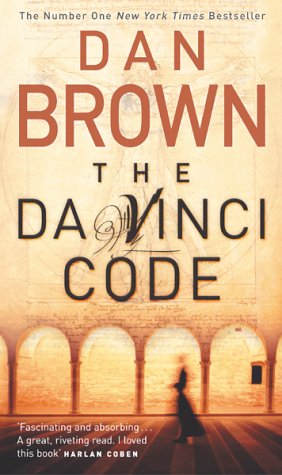

The Da Vinci Code--Dan Brown
reviewed by goodyear kirkman walker 2.2.04
 Like
my friend Jim, I don't spend a lot of time with best sellers. It doesn't seem
like the mainstream and I often agree on good books, but I became intrigued
with the "Da Vinci Code" after a Thanksgiving conversation with my
sister-in-law.
Like
my friend Jim, I don't spend a lot of time with best sellers. It doesn't seem
like the mainstream and I often agree on good books, but I became intrigued
with the "Da Vinci Code" after a Thanksgiving conversation with my
sister-in-law.
The book is, on it's face, a mystery. Usually another mark against it for me, but my bride (a mystery fanatic) has slowly inducted me into the genre. And it is a good mystery yarn. But that is not the reason to read it. Read it for the history, the current events, and mostly, for the Goddess.
It begins, like many mysteries, with a murder. The curator of the Louvre is killed after hours in the great museum. An American expert in symbols, Robert Langdon, is called in to view the crime scene, filled with hidden messages. He is joined by a French forensic cryptologist, Sophie Neveu. The couple are chased all over Paris, the French countryside and finally London by a French captain of police known as "The Bull," the Catholic Church, a swiss bank and others. The mystery portion ends with the required plot twist, another murder (using peanuts) and unexpected reunions.
But more than the plot mystery the book is about sacred mysteries. It revolves around the historical struggle between the Priory of Sion and the Catholic Church.
This is the Grail legend, and it makes little difference if you are into the Sangreal as the Cup of the Last Supper, or the San Greal, the Holy blood line, the history of the fray is well laid out. It is the story of the Church's elimination of the feminine in all aspects of our lives, and of the survival of the Goddess in the most unlikely of places, a Crusader military order.
The modern Catholic Church is represented by Opus Dei, an ultra conservative prelature of the Church that has become enormously wealthy and not a little notorious. The organization is chillingly accurately represented in the book, and the characters will haunt you with their dedication, devotion and love of pain. Check their web site for their side of the story.
The Church's antagonists are the Priory of Sion, another real organization with a purpose of protecting the Grail legend. Leonardo Da Vinci was the Master of the organization at one time, and many of his paintings provide the hidden messages of both the book's title and the murdered curator. All of the artwork and architecture in the book are quite accurately described; I will leave it to each reader to examine each piece for themselves to see if you reach the same conclusions. One warning: do not waste time with older art books in looking for the famous "Last Supper." You need to see a good picture taken of the fresco after the recent restoration brought the colors and details back to life. And if the book drives you to walk the Rose Line in Paris, the original zero meridian, so much the better. And I also leave to the book to explain to you the beauties of phi, a number ever so much more interesting than pi.